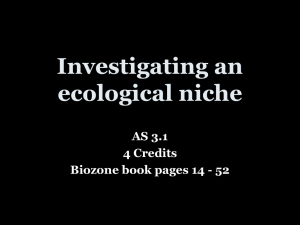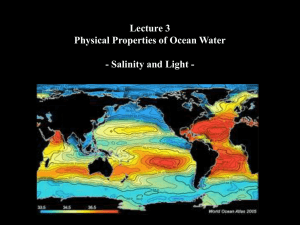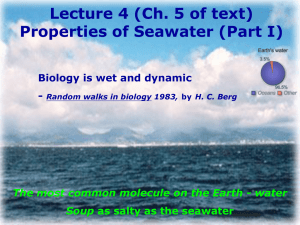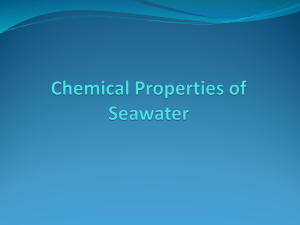Heavy Metals
advertisement
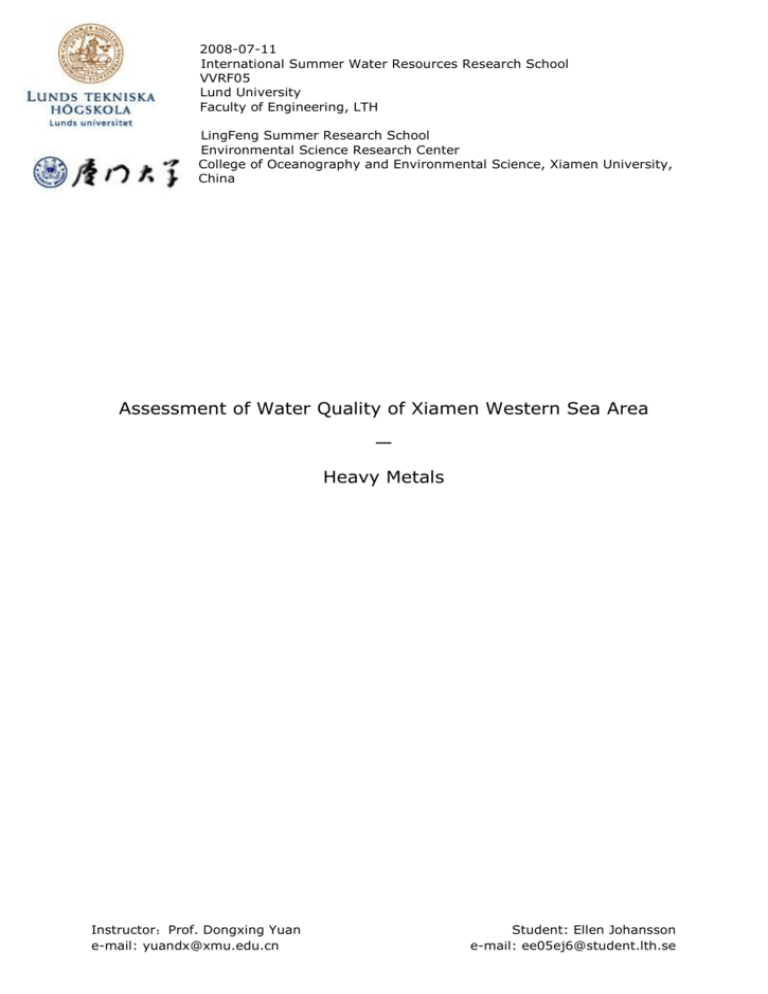
2008-07-11 International Summer Water Resources Research School VVRF05 Lund University Faculty of Engineering, LTH LingFeng Summer Research School Environmental Science Research Center College of Oceanography and Environmental Science, Xiamen University, China Assessment of Water Quality of Xiamen Western Sea Area — Heavy Metals Instructor:Prof. Dongxing Yuan e-mail: yuandx@xmu.edu.cn Student: Ellen Johansson e-mail: ee05ej6@student.lth.se Abstract Combustion in coal-fired power plants contributes sulphur dioxide and other pollutants into the atmosphere. On the east coast of China, at Songyu Electric Power Plant in Xiamen, seawater desulphurisation techniques are applied to control sulphur dioxide in the flue gas. However, the use of seawater in the neutralisation process releases both heavy metals and sulphur compounds into the sea. The purpose of this study has been to determine the concentration of 8 heavy metals in seawater, fish and sediment samples. The metals included Hg, As, Cu, Pb, Zn, Cd, Cr, Ni with a focus on Hg and As. The monitoring methods were atomic fluorescence spectrometry (AFS) and inductively coupled plasma mass spectroscopy (ICP-MS). It was found that the discharged seawater increased the concentration of heavy metals in the seawater. For As and Hg the levels ranged from 0.57-1.27 and 0.003-0.031 μg/L respectively. Furthermore the concentrations were generally lower during high tide than low tide. According to the Seawater Quality Standard (GB3097-1997) the concentrations were low and water quality was considered good. The fish samples were high in concentration of Hg and As. The sediment samples were not especially high in concentration of any of the studied heavy metals. In conclusion, additional sampling is necessary to determine the environmental effects of the power plant. There is, however, reason to belive that the power plant does not endanger the environment in a short-term perspective. 2 Table of Contents 1 Introduction ..................................................................................................... 4 2 Background ..................................................................................................... 4 2.1 Desulphurisation..................................................................................... 4 2.2 Heavy metals .......................................................................................... 6 3 Method............................................................................................................. 7 3.1 Monitoring index .................................................................................... 7 3.2 Monitoring operations ............................................................................ 7 3.2.1 Digestion ....................................................................................... 8 3.2.2 Atomic Fluorescence Spectrometry (AFS) ................................... 8 3.2.3 Inductively Coupled Plasma Mass Spectroscopy (ICP-MS) ...... 10 3.3 Monitoring sites.................................................................................... 10 3.4 Monitoring time.................................................................................... 11 4 Result and discussion .................................................................................... 12 4.1 Seawater samples ................................................................................. 12 4.2 Biological and sediment samples ......................................................... 15 5 Conclusion ..................................................................................................... 15 Acknowledgements ............................................................................................. 15 6 References ....................................................................................................... 16 Appendix 1 .......................................................................................................... 17 3 1 Introduction Heavy metals are natural components of the Earth’s crust and are essential for all life. As trace elements they are vital to maintain the metabolism of the human body. However, higher concentrations can be poisoning and harmful to both animals and plants. Examples of heavy metals include mercury (Hg), cadmium (Cd), arsenic (As), chromium (Cr), cadmium (Cd), copper (Cu), zinc (Zn) and lead (Pb). (LENNTECH) The reason for heavy metals’ toxicity is that they tend to bio accumulate in living creatures. They enter via food, water and air and bio magnify to high concentrations up the food chain. Heavy metals can get into water in different ways. Acidic rain can break down soils, releasing heavy metals into streams, lakes, rivers, and groundwater. Furthermore, industrial and consumer waste are an important source of emission. (LENNTECH) Combustion of coal in coal-fired power plants contributes traces of heavy metals as well as sulphur dioxide. On the east coast of China, at Songyu Electric Power Plant in Xiamen, seawater is used to control sulphur dioxide in the flue gas. Flue gas desulphurisation is an effective way to decrease sulphur emission and consequently pollution and acidic rain. However, the backside is that it releases heavy metals into seawater. This report will focus on the monitoring of heavy metals, especially mercury and arsenic, in the discharged seawater. The purpose is to determine the effect of the power plant on the environment. 2 Background In the following section the problem with heavy metals released by desulphurization of sea waters is described. The effect of heavy metals on the environment and human health is discussed as well as the desulphurisation process. 2.1 Desulphurisation Combustion of coal and oil results in emissions of sulphur dioxide (SO2). Sulphur dioxide as an air-born pollutant can be a health hazard to humans depending on concentration and exposure. In addition, SO2 contributes to acidic rain. To control sulphur dioxide emissions in coal or oil power plats, flue gas desulphurisation (FGD) is increasingly being installed worldwide. There are various types of FGD systems available, however the use of seawater in FGD is the first choice for thermal power plants located on the seaside. In comparison to using other alkaline chemicals, such as limestone and magnesium hydroxide, using seawater has many advantages. These will be discussed further on in the report (Oikawa et al 2003). The FGD technology is constantly progressing and a new development is the utilisation of seawater from the plants’ cooling system to scrub the S02 from the flue gas. Figure 1 shows a simplified schematic diagram of seawater FGD system. 4 Figure 1 Simplified schematic diagram of a seawater FGD system (Oikawa et al 2003) In the first step, flue gas is introduced to an absorber which is connected with seawater. Then, the scrubbed gas continues through a mist eliminator to avoid carryover of droplets, and is at last released to a stack. The desulphurization process takes place in the absorption section where SO2 in flue gas reacts with seawater according to the equations in Figure 2. Figure 2 The principal reaction of stack desulphurization (Oikawa et al 2003) The alkalinity and buffer capacity of seawater are two major characteristics in the process. Seawater has a typical pH of 7.6 to 8.4, with an alkalinity of approximately 100-110mg/l as CaCO3. The SO2 is absorbed in water to form bisulfite (HSO3-) in Equation 1. Bislulfite readily convert to sulfite (SO32-) which is a source of chemical oxygen demand (COD). HSO3- (and also SO32-) can also react with the oxygen in the flue gas and form sulphate (SO42-) as shown in Equation 2. Generally, the oxygen from the flue gas is not enough, hence the air- 5 input. This forces oxidation of HSO3- and SO32- and therefore determines the efficiency of the process Sulphate is a native constituent of seawater and less toxic than SO32-. A small increase in the dissolved solid concentration in seawater does not harm marine life. In conclusion, the process is environmentally advantageous. It provides sinks for sulphur in the atmosphere and also avoids production of soluble salt solids, calcium sulphate, since its solubility increases when present with sodium chloride in seawater. (Oikawa 2003) The neutralisation process is described in Equation 3 and 4. The netto release of heavy metals does not change, but it is possible to treat the waste water and remove heavy metals. (Higgins et al 2008) Moreover, prior to discharge the acidified seawater effluent undergoes neutralisation utilising HCO3- and CO3- already available in the seawater. It is easily performed in a separate basin by adding more water to obtain the excess alkalinity required. The process also introduces a temperature difference of less than 1° C between the effluent and the seawater, but this is within natural variations. (Oikawa 2003) In conclusion, the usage of limestone contributes to large amounts of solid and liquid waste and is therefore less cost-effectively than the use of sea water as a desulphurisation agent (Zhang et al. 2001). Furthermore, the simplicity of the process, design and operation where no additional chemicals are needed is advantageous. Also, the quality of seawater effluent can be controlled through the oxidation and neutralisation process. In spite, wet limestone processes were the dominant technology, accounting for 82 % of the wet FGD systems in 1998. 2.2 Heavy metals Combustion of coal contributes traces of heavy metals like As, Cd, Cr, Cu, Hg, Ni, Pb, Sb, Se, Sn and Zn. Hg emissions have proven to depend on fuel type and flue gas conditions. Oilfired power plants release less Hg than coal-fired power plant. Type of coal is also a major factor characterising the Hg emissions. Table 1 describes some common heavy metals and their effect on the environment. Table 1 Heavy metals and their effect on environment (LENNTECH). Metal: Arsenic (As) Cadmium (Cd) Chromium (Cr) Copper (Cu) Lead (Pb) Environmental and health effect: Exposure to inorganic arsenic can cause irritation of the stomach and intestines, decreased production of red and white blood cells, skin changes and lung irritation. A very high exposure to inorganic arsenic can cause DNA damage and infertility and miscarriages with women. In humans, long-term exposure is associated with renal dysfunction. High exposure can lead to obstructive lung disease. Cadmium may also produce bone defects (osteomalacia, osteoporosis) in humans and animals. Low-level exposure can irritate the skin and cause ulceration. Long-term exposure can cause kidney and liver damage, and damage too circulatory and nerve tissue. In high doses it can cause anaemia, liver and kidney damage, and stomach and intestinal irritation. High levels of exposure may cause problems in the synthesis of haemoglobin, effects on the kidneys, gastrointestinal tract, joints 6 Mercury (Hg) Nickel (Ni) Zinc (Zn) and reproductive system, and acute or chronic damage to the nervous system. Inorganic mercury poisoning is associated with tremors, gingivitis and/or minor psychological changes, together with spontaneous abortion and congenital malformation. Methylmercury ( CH3Hg+) is the most toxic form of mercury and causes damage to the brain and the central nervous system. Foetal and postnatal exposure has given rise to abortion, congenital malformation and development changes in young children. Long-term exposure can cause decreased body weight, heart and liver damage, and skin irritation. Nickel can accumulate in aquatic life, but its presence is not magnified along food chains. Very high levels of zinc can damage the pancreas and disturb the protein metabolism, and cause arteriosclerosis. Extensive exposure to zinc chloride can cause respiratory disorders. 3 Method 3.1 Monitoring index The monitoring index includes: a. physical items: temperature, salinity, SS (suspended solid), transparency and turbidity, total radiation. b. chemical items:pH, residual, chlorine, alkalinity, DO, COD, nutrients, oil, fluorine, PAH (polycyclic aromatic hydrocarbons), heavy metals, sulphate, sulphite. The purpose of this report is the study of heavy metals. Therefore, no other items will further be discussed in this report. The heavy metals are divided into two groups where focus will be on the first group. 1. As, Hg 2. Cu, Pb, Zn, CD, Cr, Ni 3.2 Monitoring operations There is a number of standard operations procedures for monitoring heavy metals in sea water. In this study, Atomic Fluorescence Spectrometry (AFS) and Inductively Coupled Plasma Mass Spectroscopy (ICP-MS) have been performed. The samples were divided into three different groups of analysis: a. Sea water (11 samples) b. Biological samples (2 samples) c. Sediments (2 samples) The seawater samples were filtered and analysed with the ICP-MS for the detection of heavy metals in group 2. Hg and As are analysed separately with the AFS. The organically based matrices and sediment samples need more preparation prior to analysis and this procedure is described in the next section. 7 3.2.1 Digestion For the sediment and organic samples, a digestion procedure is required prior to analysis. The reason for this is the content of oxides, clay, silicates and organic substances in these samples. The digestion method provides a rapid multi-element microwave assisted acid digestion prior to analysis. The method also provides good recoveries for very volatile elements. The microwave vessels are first cleaned with 3 mL of concentrated nitric acid (HNO3) and 0.5 hydrofluoric acid (HF) and run in the microwave for 20 minutes. For sediment samples, up to 0.5 g of the sample is digested in 3 mL of HNO3 and 0.5 mL HF for 20 minutes using microwave heating. A duplicate test sample is created from every sample. The vessels are special microwave vessels that can bear high temperature and pressure. Table 2 shows the weight of the sediment samples. Table 2 Sediment samples. Sample B2-1 B2-2 C1-1 C1-2 Weight (g) 0.2794 0.2850 0.2678 0.3355 For the biological samples 4 mL HNO3 and 1 mL H2O2 was added to the sample for the digestion. Two fish which had the following features were collected: Fish 1: 171.03 g 23.5 cm Fish 2 184.50 g 57.5 cm Two samples were taken from each of the fish and the weights are shown in Table 3. Digested samples were then analysed with inductively coupled mass spectrometry (ICP-MS). Table 3 Fish samples. Sample F1-1 F1-2 F2-1 F2-2 Weight (g) 0.3027 0.3104 0.3237 0.2667 3.2.2 Atomic Fluorescence Spectrometry (AFS) For the Hg detection a 200 mL water sample was used. First, 2 mL H2SO4 and 4 mL KMnO4 was added into the sample. 50 ml of the solution was poured into a tube with the addition of 2 mL K2S2O8 (59% w/v) and 1 mL H2SO4 (1+1). The sample was left for 24 hours to oxidize all forms of mercury into Hg2+. After 24 hours, 0.5 mL of NH2OH·HCl was added into the sample to reduce the excessive KMnO4. 1 mL of HCl (1+1) was added to lower the pH. To reduce the Hg2+ to elemental Hg, 0.5 mL of SnCl2 was added. The sample has to be analysed immediately and was bubbled with nitrogen gas for 10 minutes. The bottle used in the bubble process is connected to a golden column which traps the Hg. The sample column is heated and the Hg vaporizes to the analyze column which is analyzed with cold atomic fluorescence spectrometry (CA-AFS) for detection of Hg. The gas used in the AFS is Argon gas. Nitrogen gas can affect the fluorescence negatively. 8 For the As detection 5 mL of thiourea (CSN2H4) was added into 50 mL of seawater sample. The reagent reduces As5+ o As3+. To vaporise the arsenic, 2.5 mL of HCL was added to the sample. The reaction is described below: 3BH4- +3H+ + 4H3AsO3 → 3H3BO3 + ASH3 + 3H2O To calculate the concentrations in the sample a standard addition method is used. A standard solution of 1000 ppb As3+ was added in different volumes to three sampling tubes. The first tube was filled with 10 mL of the water sample and no standard solution was added. The second and third tube was filled with the same volume of water sample but also 2.5 and 5 mL of standard solution respectively. An example of the standard curve is shown in Figure 3 and the calculated values are to be found in Table 4. Table 4 Calculated values, standard addition method. Fluorescence average Site C1Hdp V std sample (μL) Fluorescence - blank 389.333 0 15.333 407.333 2.5 33.333 444.333 5 70.333 C(μg/L) 1.106 80 y = 11x + 12.167 R 2 = 0.9617 70 60 50 40 30 20 10 0 0 1 2 3 4 5 6 Figure 3 Standard curve for As detection In Figure 3 the sample concentration is found where the value of y is zero. For tube 1 the concentrations is the value of x, for tube 2 it is x-2.5 mL and for tube 3 it is x-5 mL. The critical point in the method is preventing samples from becoming contaminated during the sampling and analysis process. Samples may become contaminated in numerous ways. Sources of contamination may be metallic or non-metallic lab ware (e.g. talc gloves can contain high levels of zinc), reagents, dirty equipment, atmospheric inputs such as dirt and dust etc. The only way to control contamination is to ensure that any object or substance that contacts the sample is metal free and free from any material that may contain mercury. In reality, contamination is avoided by performing operations in areas free from contamination, e.g. class-100 clean rooms or similar. Secondly, apparatus exposure shall be minimized by for instance frequent cleaning and good storage. Thirdly, clean work surfaces is required as well as usage of gloves among sampling personnel. Lastly, only fluoropolymer or glass containers must be used for collection of sample to avoid diffusion of mercury out of the container. 9 Contamination can also be avoided by avoiding sources of contamination. Among these are contamination by carryover, by samples and by indirect contact. Contamination by carryover is when a sample with low concentration is processed immediately after a sample containing higher levels. This problem is solved by always analyzing samples suspected to contain the lowest concentrations prior to those with higher levels. Contamination by samples, on the other hand, can be avoided by diluting samples suspected to contain Hg concentrations higher than 100 ng/L. In this study, there are no problems with contamination from high concentrations. Efforts have been made to avoid the other sources of contamination but the author of the report suspects possible contamination from a couple of different sources. Among these can be mentioned a metallic knife used to prepare the sample from the fish, metallic jewellery on lab personal, dirty equipment etc. Safety precautions, apparatus and material requirements, quality control and suggested calibration steps are described in Method 1631, Revision E – August 2002 and is not discussed further in this review. 3.2.3 Inductively Coupled Plasma Mass Spectroscopy (ICP-MS) 50 mL of deionised water was added to the biological samples before they were analysed with the ICP-MS. For the sediment samples, 40 mL of deionised water was added. The samples were analysed for 40 seconds and a value of the mean concentrations was achieved. The detection methods used for the 8 heavy metals are summarized in Table 5. Table 5 Detection of heavy metals. Metal Method/instrument Arsenic mercury copper Lead zinc cadmium chromium HG-AFS CA-AFS ICP-MS ICP-MS ICP-MS ICP-MS ICP-MS Detection limit (μg/L)) 0.0510 0.0710 0.0210 0.0210 0.0110 0.0110 0.0210 nickle ICP-MS 0.0210 HG-AFS: hydride generation atomic fluorescence spectrometry ICP-MS : Inductively coupled plasma mass spectroscopy 3.3 Monitoring sites Samples were collected at 11 different monitoring sites in the Western Sea area outside of Xiamen. The locations are shown in Figure 3 a. 4 sites are located on land, D1, D2, D3 and D4, inside the power plant. The sites are the water inlet, in the desulphurisation process and two sites in the aeration tank. b. 1 site, W, is located inside a sewage plant near the Songyu power plant. c. 5 sites are located in the sea, A1, A2, B1, B2, B3, C1. 10 1./ A1, A2 are located 70 m from the outlet and typically have the highest levels of mercury. 2./ B1, B2, B3 are located at a distance of 400 m from the power plant. B1 is upstream and B3 downstream the power plant. B2 is opposite the outlet. B1 has very special conditions since the river brings freshwater from the left and creates estuarine conditions. 3./ This collection, the reference site C1, was moved just north of Ji Island, due to too many ships operating the previous area causing pollutants in the seawater. Figure 4 Monitoring sites (A1, A2, B1, B2, B3, C1) “////” is the area likely to be affected by the power plant. 3.4 Monitoring time Samples are collected 2 times a year, monitoring both high and low water season as well as high and low tide. The tide does only affect the water samples and sediment samples can be taken independently. The sampling has to be performed on a day with no rainfall or less the seawater will not be representative. In this report, samples were collected on the 22nd of June 2008 and the weather was sunny with no rainfall. 11 4 Result and discussion The following discussion will be focused on As and Hg in the 5 sites located in the sea. Sediment and fish samples will only be briefly discussed. 4.1 Seawater samples For the arsenic in seawater the monitoring results are found in Table 6. Table 6 As concentration in seawater samples dp - duplicate, H - high tide, L - low tide Site A1H A2H B1H B2H B3H C1H C1Hdp A1L A2L B1L B2L B3L C1L C1Ldp D1 D2 D3 D4 W C test sample (μg/L) 1.08 0.95 0.68 0.69 0.58 0.58 1.11 0.89 1.23 0.49 0.63 0.74 1.05 1.33 0.97 1.93 0.86 0.45 2.70 C sample (μg/L) 1.24 1.10 0.78 0.80 0.67 0.67 1.27 1.02 1.41 0.57 0.72 0.85 1.20 1.52 1.11 2.22 0.99 0.52 3.11 Test sample: seawater 57.5:50 mL dp - duplicate, H - high tide, L - low tide According to Table 6, the concentration of As was higher at the A1 and A2 at both low and high tide compared to sites further away from the outlet. C1, which is supposed to be located outside of the affected area, is according to the result not a good reference site. W was naturally high since the site is located in the wastewater plant. The D-sites showed a clear pattern. D1 is the water inlet and that explains the low concentration. D2 was very high in As concentrations due to the location in the process. The desulphurisation process is not completed and this should explain the high concentration. For D3 and D4 the concentrations are lower and this is most likely due to some of the metals vaporizing in the aeration tank. It is clear that the power plant increases the amount of heavy metals in the sea. However, for the sea sites the concentrations ranged between 0.57-1.27 μg/L and seawater with Asconcentrations below 20 μg/L was classified as class 1 by the Seawater Quality Standard (GB3097-1997). Class 1 for seawater is definied as water approved for marineculture and the seawater is not consider polluted by As. 12 The results also show that the concentrations were generally lower at high tide than low tide. At low tide, the water from Jiulong Jiang River contributes more to the total water volume than at high tide. The river is further exposed to human activities than the sea and during low tide the concentration of pollutants will therefore increase. The result for mercury in the seawater samples is shown in Table 7. Table 7 Hg concentration in seawater samples dp - duplicate, H - high tide, L - low tide Site A1H A2H B1H B2H B3H C1H C1Hdp A1L A2L B1L B2L B3L C1L C1Ldp D1 D2 D3 D4 W C test sample (μg/L) 0.013 0.009 0.010 0.006 0.007 0.006 0.007 0.000 0.009 0.010 0.013 0.008 0.006 0.007 0.002 0.012 0.007 0.008 0.005 C sample (μg/L) 0.011 0.007 0.008 0.004 0.005 0.004 0.005 0.003 0.031 0.008 0.011 0.006 0.009 0.004 0.005 0.674 0.076 0.086 0.017 dp - duplicate, H - high tide, L - low tide Table 7 shows that concentrations of Hg were slightly higher at low tide than high tide and this should be explained as in the case of As. The Hg concentration in the sea sites ranged between 0.003-0.031 μg/L and for concentrations lower than 0.05 μg/L, seawater is classified as class 1. This is applicable for all sites except the sites inside of the power plant. The D-sites show the same pattern as for As. In the short term perspective, there is no reason to believe that the mercury or arsenic emissions will harm the environment. However, more sampling is necessary to determine the long-term effects of the emissions. 13 For the metals in group 2, the result is presented in Table 8. Table 8 Group 2 heavy metals concentration in seawater samples Site 52 Cr 60 Ni 65 Cu 66 Zn Concentration (μg/L) 114 Cd 208 Pb A1H A1L A2H A2L B1H B1L B2H B2L B3H B3L C1H (mean) C1L (mean) D1 D2 D3 D4 W 20.18 1.31 0.97 0.79 1.26 1.6 1.04 1.35 1.03 1 30.91 1.69 0.82 0.56 1.45 2.81 1.04 1.96 0.66 1.26 2.29 1.52 1.56 1.6 1.65 1.71 1.19 2.46 1.7 1.41 6.89 10.5 11.25 12.47 17.23 13.84 7 18.63 17.56 13.57 0.25 0.15 0.35 0.2 0.25 0.45 0.36 0.19 0.27 0.23 0.5 0.54 1.18 0.89 0.68 1.68 0.96 0.85 0.68 0.69 1.35 1.30 1.48 26.89 0.29 0.94 0.90 1.52 3.19 1.02 1.07 3.91 1.24 1.2 2.89 1.31 1.04 22.02 1.84 1.54 9.75 1.26 1.3 2.14 14.30 9.91 33.77 17.21 9.67 39.44 0.24 0.17 0.22 0.18 0.2 0.17 1.20 13.52 15.52 0.73 0.61 1.08 It was observed that concentrations of Cr and Ni were much higher close to the outlet of the power plant. Also, Cu and Pb were higher in concentrations in these sites. The only two metals that were low in concentration close to the outlet were Zn and Cd. A compilation of the results for the sea sites is shown in Table 9. Table 9 Heavy metal concentration in seawater at sea sites Metal As Hg Cr Ni Cu Zn Cd Pb Concentration (μg/L) 0.57 - 1.27 0.003 - 0.031 0.79 - 20.18 0.56 - 30.91 1.19 - 2.29 6.89 - 26.89 0.15 - 0.45 0.5 - 1.20 Classification Class 1 Class 1 Class 1 N/A Class 1 Class 2 Class 1 Class 1 14 4.2 Biological and sediment samples Table 10 shows the results for the fish and sediment samples. The negative numbers means that the heavy metal concentration was very low or non-existent. Table 10 Heavy metal concentration in biological and sediment samples Site 52 Cr 60 Ni F1 F2 B2 C1 -0.03 0.03 26.259 23.921 -0.06 0 14.46 13.254 65 Cu 66 Zn 75 As Concentration (mg/Kg) -0.18 1.98 0.48 0.08 24.18 1.16 14.344 91.193 5.675 15.306 104.659 6.452 114 Cd 200 Hg 208 Pb 0 0 0.284 0.424 0.19 0.08 0.0836 0.105 -0.14 -0.11 40.826 59.015 Fish 1 was very high in concentrations of Hg. According to Biological Quality Standard (GB18421-2001), the classification for this concentration is class 3. Fish 2 was classified class 2 for Zn and Hg. Since the sampling of fish was very spare, no conclusions were made about fish in the Western Sea are. The sediment samples were low in concentrations of all the studied heavy metals, but Hg and As concentrations are slightly higher. All concentrations passed the limitations for class 1 for sediment quality. Sediment Quality Standard (dry weight) (GB18668-2002) 5 Conclusion It is the author’s opinion that additional sampling is required to determine the long-term environmental effects of the power plant. Weather conditions and seasonal variations can affect the concentrations and hence the result. Therefore, not only additional sampling but frequent sampling is required to cover all different conditions. Furthermore, seawater samples were collected only at the surface of the sea. Sampling could be extended to study variation in concentration at different depths. The most critical point in this sudy has been the sampling and to avoid contamination in this step. In the future, it is possible to improve the actions taken to avoid contamination. For example, increased use of single-use equipment is possible etc. There is reason to belive that the power plant does not harm the environment in a short-term perspective. Neither seawater, sediment or fish is considered seriously polluted by any of the metals according to standards in Appendix 1. Still, it is clear that the most toxic metals like Hg and As are those that tend to be higher in concentration and this should be investigated further. It is also worth noticing that in spite of emissions being spare, a coal fired power plant is always an environmental risk to the surrounding area. Acknowledgements The author of this report would like to thank Prof. Dongxing Yuan for useful comments on laboratory work and report-writing. Special thanks also go to research assistant Liqian Yin for her patience while instructing and sharing her knowledge and experience. 15 6 References Literature: D.N. Zhang, Q.Z. Chen, Y.X.Zhao, Y. Maede, Y. Tsujino, Stack Gas Desulfurization by seawater in Shanghai, Water, Air, ans Soil Pollution 130:271-276, 2001. Katsuo Oikawa, Chaturong Tongsiri, Kazuo Takeda and Takayoshi Harimoto, Seawater Flue Gas Desulfurization: Its Technical Implications and performance Results. Environmental Progress (Vol. 22, No.1) K.S Park, Y.-C. Seo, S.J. Lee, J.H. Lee, Emission and Speciation of Mercury from Various Combustion Sources, Powder Technology 180 (2008) 151-156 M. Betinelli, G.M. Beone, S. Spezia, C. Baffi, Determination of heavy metals in soils and sediments by microwave-assisted digestion and inductively coupled plasma optical emission spectrometry analysis. Analytica Chimica Acta 424 (2000) 289-296. Method 1631, revision E; Mercury in Water by Oxidation, Purge and Trap, and Cold Vapour Fluorescence Spectrometry,EPA-821-R-02-019, August 2002 Ravi K. Srivastava, Wojciech Josexics , Carl Singer, SO2 Scrubbing Technologies: a Review Thomas Higgins; Silas Givens; Tom Sandy, FGD Wastewater Treatment still has a Ways to Go, Powe Engineering; Jan 2008; 112, 1; ABI/INFORM GLOBAL Internet: http://www.lenntech.com/heavy-metals.htm 2008-05-22 16 Appendix 1 1.1 a) Seawater Quality Standard (GB3097-1997) mg/L Heavy metal Hg≤ Cd≤ Pb≤ Cr≤ As≤ Cu≤ Zn≤ Class 1 0.00005 0.001 0.001 0.05 0.020 0.005 0.020 Class 2 0.0002 0.005 0.005 0.10 0.030 0.010 0.050 Class3 Class 4 0.0005 0.010 0.010 0.20 0.050 0.050 0.10 0.050 0.50 0.50 1.1 b) Sediment Quality Standard (dry weight) (GB18668-2002) mg/kg Type Class 1 Class 2 Class 3 Sulfate(≤) 300.0 500.0 600.0 TOC (≤) 2.0 3.0 4.0 Oil (≤) 500.0 1000.0 1500.0 Hg(≤) 0.20 0.50 1.00 Cu(≤) 35.0 100.0 200.0 Pb(≤) 60.0 130.0 250.0 Cd(≤) 0.50 1.50 5.00 Cu(≤) 150.0 350.0 600.0 Cr(≤) 80.0 150.0 270.0 As(≤) 20.0 65.0 93.0 1.1 c) Biological Quality Standard (GB18421-2001) mg/kg Type Class1 Class2 Class3 Total; Hg(≤) 0.05 0.10 0.30 Cu(≤) Pb(≤) Cd(≤) Zn(≤) Cr(≤) As(≤) 10 25 50(oyster100) 0.1 2.0 6.0 0.2 2.0 5.0 20 50 100(oyster500) 0.5 2.0 6.0 1.0 5.0 8.0 17

